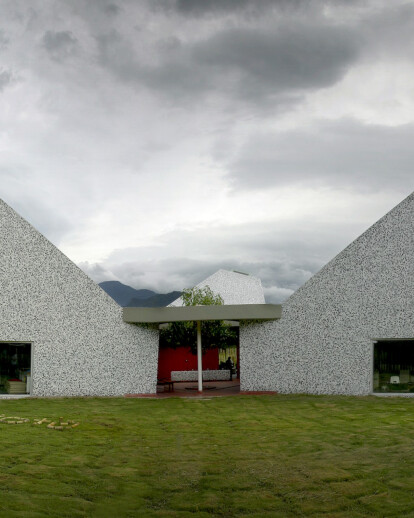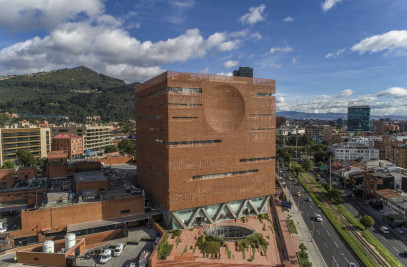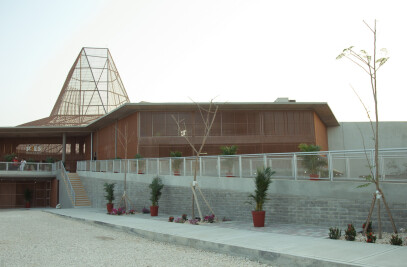PRESCHOOL EARLY CHILDHOOD IN Timayui, SANTA MARTA, COLOMBIA.
1 - PROGRAM NEEDS AND preconditions. The project is part of the policies of the mayor of Santa Marta and Carulla Foundation to improve educational and nutritional conditions of the communities displaced by violence field and settled on the outskirts of the city, aims to develop infrastructure to improve early childhood conditions in low-income neighborhoods to the most vulnerable population between 0-5 years old, areas characterized by violence and the lack of public infrastructure.
2 - THE PRESCHOOL AS A MECHANISM OF SOCIAL INCLUSION. The challenge as architects in a context like Colombia is to develop projects that are capable of generating social inclusion, the problem is not only implement and deteriorating buildings in areas if we do not like to be able to activate new forms of use, ownership and pride in the communities.
Open Architecture. Such interest has not search open architectures capable of being changeable and adaptable to new social and cultural challenges, we are interested in organizational systems composed of parts or modules as intelligent organizational mechanism which is not closed or finished their adaptive capacity allows them to grow or adapt to the most diverse situations, itself allows us to develop various models based on the same rules of organization that can be repeated in different places of the city making it more economical and sustainable projects raised by us in these zones.
Multiply use. The indeterminacy as design strategy allows us to think that the architecture we do is able to multiply the uses for which it was originally intended (not as effective if not as a pledge of new relationships), the disposition and set the buildings can not leave places functionally defined, that makes communities can appropriate and multiply the initial use.
An architecture pregnante. With this condition we transfer consolidated city periphery areas and deteriorating in which we operate. Public buildings in these areas should be identified by communities as state presence and support elements for social transformation, which is why we seek to develop architectures pregnantes, with provisions making the inhabitants participate in the sector and that they feel part a more just and egalitarian society, this allows high levels of ownership and pride in the communities where our buildings are inserted.
3 - RATIONALE FOR PROPOSED URBAN INTEGRATION. The building is conceived as a visible structure, a landmark, representative and symbol of the neighborhood, is a way to parent in the sector, which by its very form differs from the contexts that surround it, a context without urban planning and this will become a unifying and an element of pride for the community.
The image of the building refers to the geography of the region, rather than an architectural object landscape intend to develop a building that relate to geography and topography or where it is inserted, we find rules of organization to develop projects that promote a "new natural contract ", reformulating the relationship between these two (figure and ground), an approach in the search for alternative ideas can favor this" new natural contract "in tune with a landscape and natural order.
4 - RATIONALE FOR ORGANIZATIONAL SOLUTION ADOPTED.
MODULE AND ADAPTIVE SYSTEMS
System Our project is developing a functional strategy, spatial and environmental system based on a modular or repeated patterns that can be connected in various ways, allowing you to adapt to various urban situations, educational, topographical or geometric.
More than a finished and closed architecture we propose the development of an open and adaptive system, consisting of modules in bloom, they are able to adapt to the most diverse situations, whether topographical, urban or programmatic; generating buildings ready to grow, change and adapted according to particular circumstances or temporary, a strategy that allows for changes, accidents and intercambiabilidades, designed more as a method than as a permanent and exist only by virtue of its ability to change.
This model is being built two preschools in the towns of La Paz and Bureche on the outskirts of Santa Marta
The Module We propose the development of a flower-shaped module (each with three arms program, and a central courtyard), which can rotate in the connecting ends to take the best position in the lot and with respect to other modules , forming the chain system.
The spatial configuration of the understanding of Malaguzzi Loris pedagogical philosophy, which was born the idea of creating an element that suggests 3 interrelated centralities, and which cause a range of situations and experiences among children, teachers and family.
5 - GENERAL CHARACTERISTICS OF THE BUILDING The buildings have a bearing wall system in shotcrete easy deployment and rapid construction, these walls serve as the support membranes eliminates columns and beams supporting system, allowing 4-meter overhangs at the ends of the classroom. These walls are coated with ceramic elements (Venetian mosaics) which helps the maintenance and cleaning of the building.
The construction system allows to build the 1,450 m2 in seven months, typifying or modulating the panels to be reused in other models.
SUSTAINABLE ARCHITECTURE The project aims at sustainability from several fronts to improve the urban environment by raising awareness of the population considering current and future generation, trying to bring about social change and ethical covering a development model for the surrounding population.
The project is buildable and occupancy conditions, such as thermally regulated power through the facade wall system supported high thermal efficiency with natural ventilation, which prevents the use of air conditioning reduces energy consumption not only in the normal maintenance Kindergarten, also this wall construction system also reduced energy consumption on site, the materials used in construction waste minimized the amount of work down the environmental impact, building orientation is south-north, his architectural configuration allows natural ventilation and natural lighting, the project includes areas with floral ornamentation, gardens to urban agriculture contributes to improving environmental quality, landscape and urban economic and population respectively.
It optimizes the use of water saving devices to use, rain water recycling and gray for later use in bathrooms, in cultures and if spare, can benefit the surrounding community. The recycling of waste management is done from the source so that it can deliver the collection system by lowering the cost of this service and in turn generating revenue for the Garden, in the case of the sale of recyclable materials. The waste produced in the kitchen are used to generate compost used subsequently for crop areas. The project is socially engaged not only for being a garden social welfare support early childhood, but through support urban farming families to promote the use of natural resources with an economic purpose and compensation for personal monetarily.
"The project" Urban Agriculture ", contributes to food security and nutrition, environmental sustainability, social fabric construction, consolidation of integral processes of participation, involvement and ownership of the territory," alternative to overcome poverty and exclusion affects a large percentage of the population ........ "
The project implements agriculture and productivity as complementary thematic development of educational activities, it is intended, as well as expressed in the previous paragraph, give to the community and the individual the opportunity to be productive for own benefit and collective. The agricultural project is a productive instrument that is based on the following areas:
6 - SCHOOL OF ARCHITECTURE AS PLACE OF TRAINING. The architecture is able to generate behavior and produce learning situations, which is why we believe that the school environment is in itself a learning mechanism, we are able to teach you a child of the first child in the use of materials that is soft vs hard, open vs. closed, hot vs. cold, and many other options to use.
The model seeks to value all schools as places of training, this is given not only in the classroom but also in the vacuum of the circulations and yards as a Variable able to embrace change of activities, events and outer space, a place for games, dreams, roles.
This search presupposes the search of creating educational ENVIRONMENTS (te-qualifications) instead of architectures, the goal is to evolve abstract organization system to a system of relations of environments (Mainland pedagogical), in which objects are not only working for layout , but it is created through interaction. Systems environments (machine perceptions) betting on a sequence of linear paths and changing themes against distribution spaces which are not capable of enhancing the appearance of undetermined space for a multiplicity of events. For this raised areas with the following characteristics for training.
The school space as a hidden curriculum: - The School as an Instrument Educational Space. Spaces themed-language corner, shop of dolls, etc.. The school space as a place of Cohabitation and Relationships. The sub spaces patios for you meeting the school community. Scope Space as Aesthetic school. The reference image to the world, - trees, animal tracks - etc. School Space as Meaning Territory. - Reference to areas of the city, parking-authority - my space, subspace and so on.

































